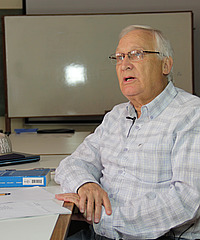Victoria Torres de FAMAF – UNC
Título: Álgebras de operadores diferenciales asociadas a pesos matriciales
Resumen:
Dado un peso W, se puede asociar una subálgebra del álgebra de Weyl, denotada D(W), compuesta por todos los operadores diferenciales que tienen como autofunción a la familia de polinomios ortogonales respecto a ese peso. En el caso escalar, esta álgebra es conmutativa y está generada por un operador diferencial de segundo orden. Sin embargo, en el caso matricial, la estructura de D(W) puede ser mucho más compleja y no siempre es completamente conocida.
En esta charla presentaré herramientas para estudiar esta estructura. Comenzaremos con el caso particular en que el peso es una suma directa de pesos clásicos, describiendo explícitamente su álgebra de operadores diferenciales. Luego, estudiaremos la acción de las transformaciones de Darboux sobre estas álgebras y cómo estas permiten generar nuevos ejemplos. Finalmente, exploraremos el álgebra de autovalores asociada y el centro de D(W), con énfasis en resultados recientes sobre su caracterización y propiedades algebraicas.
Bibliografía:
Bono Parisi, I., & Pacharoni, I. (2023). Darboux transformations and the algebra $\mathcal {D}(W) $. arXiv e-prints, arXiv-2311.
Bono Parisi, I., & Pacharoni, I. (2025). Structure of operator algebras for matrix orthogonal polynomials. arXiv e-prints, arXiv-2502.
Bono Parisi, I., & Pacharoni, I. (2024). The algebra $\mathcal {D}(W) $ via strong Darboux transformations. arXiv e-prints, arXiv-2403.
Bono Parisi, I., Pacharoni, I., & Zurrián, I. (2024). Darboux equivalence for matrix-valued orthogonal polynomials. arXiv e-prints, arXiv-2407.
Casper, W. R., & Yakimov, M. (2022). The matrix Bochner problem. American Journal of Mathematics, 144(4), 1009-1065.
Grünbaum, F. A., & Tirao, J. (2007). The algebra of differential operators associated to a weight matrix. Integral equations and operator theory, 58(4), 449-475.Tirao, J., & Zurrián, I. (2018). Reducibility of matrix weights. The Ramanujan Journal, 45, 349-374.

